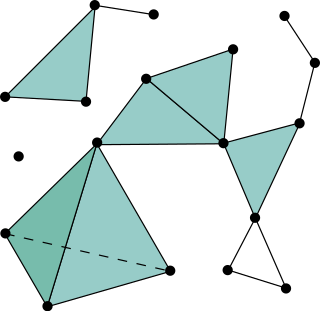Definition
For a simplicial complex , the group of -chains of is given by:
where are singular -simplices of . Note that an element in is not necessarily a connected simplicial complex.
In algebraic topology, a k-chain is a formal linear combination of the k-cells in a cell complex. In simplicial complexes (respectively, cubical complexes), k-chains are combinations of k-simplices (respectively, k-cubes), [1] [2] [3] but not necessarily connected. Chains are used in homology; the elements of a homology group are equivalence classes of chains.
For a simplicial complex , the group of -chains of is given by:
where are singular -simplices of . Note that an element in is not necessarily a connected simplicial complex.
Integration is defined on chains by taking the linear combination of integrals over the simplices in the chain with coefficients (which are typically integers). The set of all k-chains forms a group and the sequence of these groups is called a chain complex.


The boundary of a chain is the linear combination of boundaries of the simplices in the chain. The boundary of a k-chain is a (k−1)-chain. Note that the boundary of a simplex is not a simplex, but a chain with coefficients 1 or −1 – thus chains are the closure of simplices under the boundary operator.
Example 1: The boundary of a path is the formal difference of its endpoints: it is a telescoping sum. To illustrate, if the 1-chain is a path from point to point , where , and are its constituent 1-simplices, then
Example 2: The boundary of the triangle is a formal sum of its edges with signs arranged to make the traversal of the boundary counterclockwise.
A chain is called a cycle when its boundary is zero. A chain that is the boundary of another chain is called a boundary. Boundaries are cycles, so chains form a chain complex, whose homology groups (cycles modulo boundaries) are called simplicial homology groups.
Example 3: The plane punctured at the origin has nontrivial 1-homology group since the unit circle is a cycle, but not a boundary.
In differential geometry, the duality between the boundary operator on chains and the exterior derivative is expressed by the general Stokes' theorem.

In geometry, a simplex is a generalization of the notion of a triangle or tetrahedron to arbitrary dimensions. The simplex is so-named because it represents the simplest possible polytope in any given dimension. For example,
In mathematics, a chain complex is an algebraic structure that consists of a sequence of abelian groups and a sequence of homomorphisms between consecutive groups such that the image of each homomorphism is contained in the kernel of the next. Associated to a chain complex is its homology, which is a measure of the failure of a chain complex to be exact.
In mathematics, the term homology, originally introduced in algebraic topology, has three primary, closely-related usages. The most direct usage of the term is to take the homology of a chain complex, resulting in a sequence of abelian groups called homology groups. This operation, in turn, allows one to associate various named homologies or homology theories to various other types of mathematical objects. Lastly, since there are many homology theories for topological spaces that produce the same answer, one also often speaks of the homology of a topological space. There is also a related notion of the cohomology of a cochain complex, giving rise to various cohomology theories, in addition to the notion of the cohomology of a topological space.

In mathematics, a simplicial complex is a structured set composed of points, line segments, triangles, and their n-dimensional counterparts, called simplices, such that all the faces and intersections of the elements are also included in the set. Simplicial complexes should not be confused with the more abstract notion of a simplicial set appearing in modern simplicial homotopy theory. The purely combinatorial counterpart to a simplicial complex is an abstract simplicial complex. To distinguish a simplicial complex from an abstract simplicial complex, the former is often called a geometric simplicial complex.

In the mathematical disciplines of topology and geometry, an orbifold is a generalization of a manifold. Roughly speaking, an orbifold is a topological space that is locally a finite group quotient of a Euclidean space.
In algebraic topology, the Betti numbers are used to distinguish topological spaces based on the connectivity of n-dimensional simplicial complexes. For the most reasonable finite-dimensional spaces, the sequence of Betti numbers is 0 from some point onward, and they are all finite.
In mathematics, particularly algebraic topology and homology theory, the Mayer–Vietoris sequence is an algebraic tool to help compute algebraic invariants of topological spaces. The result is due to two Austrian mathematicians, Walther Mayer and Leopold Vietoris. The method consists of splitting a space into subspaces, for which the homology or cohomology groups may be easier to compute. The sequence relates the (co)homology groups of the space to the (co)homology groups of the subspaces. It is a natural long exact sequence, whose entries are the (co)homology groups of the whole space, the direct sum of the (co)homology groups of the subspaces, and the (co)homology groups of the intersection of the subspaces.
In algebraic topology, singular homology refers to the study of a certain set of algebraic invariants of a topological space , the so-called homology groups Intuitively, singular homology counts, for each dimension , the -dimensional holes of a space. Singular homology is a particular example of a homology theory, which has now grown to be a rather broad collection of theories. Of the various theories, it is perhaps one of the simpler ones to understand, being built on fairly concrete constructions.

In mathematics, the barycentric subdivision is a standard way to subdivide a given simplex into smaller ones. Its extension on simplicial complexes is a canonical method to refine them. Therefore, the barycentric subdivision is an important tool in algebraic topology.
In topology, a branch of mathematics, intersection homology is an analogue of singular homology especially well-suited for the study of singular spaces, discovered by Mark Goresky and Robert MacPherson in the fall of 1974 and developed by them over the next few years.
In mathematics, a simplicial set is a sequence of sets with internal order structure and maps between them. Simplicial sets are higher-dimensional generalizations of directed graphs.
In algebraic topology, simplicial homology is the sequence of homology groups of a simplicial complex. It formalizes the idea of the number of holes of a given dimension in the complex. This generalizes the number of connected components.

In mathematics, triangulation describes the replacement of topological spaces with simplicial complexes by the choice of an appropriate homeomorphism. A space that admits such a homeomorphism is called a triangulable space. Triangulations can also be used to define a piecewise linear structure for a space, if one exists. Triangulation has various applications both in and outside of mathematics, for instance in algebraic topology, in complex analysis, and in modeling.
In topology, Borel−Moore homology or homology with closed support is a homology theory for locally compact spaces, introduced by Armand Borel and John Moore in 1960.
In mathematics, Kan complexes and Kan fibrations are part of the theory of simplicial sets. Kan fibrations are the fibrations of the standard model category structure on simplicial sets and are therefore of fundamental importance. Kan complexes are the fibrant objects in this model category. The name is in honor of Daniel Kan.
In algebraic topology, the pushforward of a continuous function : between two topological spaces is a homomorphism between the homology groups for .
In mathematics, a Δ-set, often called a Δ-complex or a semi-simplicial set, is a combinatorial object that is useful in the construction and triangulation of topological spaces, and also in the computation of related algebraic invariants of such spaces. A Δ-set is somewhat more general than a simplicial complex, yet not quite as sophisticated as a simplicial set. Simplicial sets have additional structure, so that every simplicial set is also a semi-simplicial set.
In mathematics, a Stanley–Reisner ring, or face ring, is a quotient of a polynomial algebra over a field by a square-free monomial ideal. Such ideals are described more geometrically in terms of finite simplicial complexes. The Stanley–Reisner ring construction is a basic tool within algebraic combinatorics and combinatorial commutative algebra. Its properties were investigated by Richard Stanley, Melvin Hochster, and Gerald Reisner in the early 1970s.
A simplicial map is a function between two simplicial complexes, with the property that the images of the vertices of a simplex always span a simplex. Simplicial maps can be used to approximate continuous functions between topological spaces that can be triangulated; this is formalized by the simplicial approximation theorem.
Discrete calculus or the calculus of discrete functions, is the mathematical study of incremental change, in the same way that geometry is the study of shape and algebra is the study of generalizations of arithmetic operations. The word calculus is a Latin word, meaning originally "small pebble"; as such pebbles were used for calculation, the meaning of the word has evolved and today usually means a method of computation. Meanwhile, calculus, originally called infinitesimal calculus or "the calculus of infinitesimals", is the study of continuous change.